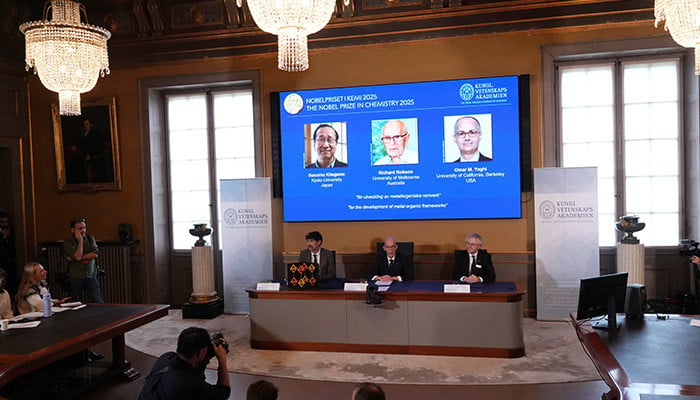On Wednesday, three scientists won the Nobel Prize in Chemistry for the development of a method for designing molecular structures whose multiple applications consist of tackling climate change by taking care of carbon dioxide and harvesting water from the desert air.
The Japanese Susumu Kitagawa, Richard Robson, born in Great Britain and the American-Jordanian Omar Yaghi were honored for their groundbreaking discoveries that date from late 1980s to the early 2000s.
Thanks to the discoveries of the trio, according to the jury, chemists could have built tens of thousands of so -called metal organic frameworks (MOFs).
“Some of these can contribute to solving some of the biggest challenges of humanity,” it added.
The applications such as “separating PFAS from water, breaking down traces of pharmaceutical substances in the environment, the absorption of carbon dioxide or harvesting water from desert air”.
Revolutionary discoveries
In 1989, Robson, 88, tested the properties of atoms in a new way with the help of copper ions.
“When they were combined, they formed a well -organized, spacious crystal,” said the jury. “It was like a diamond filled with countless cavities.”
While Robson, a professor at the University of Melbourne, realized the potential of his discovery, the molecular construction was unstable.
They were Kitagawa, professor at the University of Kyoto, and Yaghi, professor at the University of California, Berkeley, who provided a good basis for the construction method.
Between 1992 and 2003 they made a series of revolutionary discoveries separately from each other.
Kitagawa “showed that gases can flow in and out of the constructions and predicted that Mof’s could be made flexible,” the jury said.
Yaghi created “a very stable sleeve” and showed that it could be adjusted with the help of a rational design, giving the new and desirable properties, “it added.
‘Like a sponge’
In response to the prize, specialists from the field agreed on the importance of the work.
For Dorothy J. Phillips, chairman of the American Chemical Society, the most exciting application was the capture of carbon dioxide.
“We are in the middle of climate change, we really want to do things such as following and reducing the carbon dioxide … That is a great application,” she told AFP.
Ross Forgan, professor of material chemistry at the University of Glasgow, told AFP that MOFs can be described as “solids that are full of holes”.
“They have a ridiculously high storage capacity because they are hollow, and they can absorb other molecules as a sponge,” Forgan said.
David Fairen-Jimenez, a professor studying MOFs at the University of Cambridge, explained that they could also be assembled to make new ‘functional materials’.
“It is very easy to imagine as a molecular building game,” he added, making a comparison with “playing with LEGO”.
‘A whole journey’
In an interview with the Nobel Foundation, Yaghi said that he was “surprised, excited and overwhelmed” when he heard that he had won the prize.
He was at an airport that changed flight when the academy called him to announce the news.
Yaghi was born in a family of Palestinian refugees in Amman, Jordan.
“I grew up in a very modest family,” he said. “And you know, we were ten in one small room, which we shared with the cattle that we used to breed.”
The school offered a refuge for Yaghi, according to the Royal Swedish Academy of Sciences in its statement. He moved to the US at the age of 15 to study.
“So it’s quite a journey,” he said – and science had enabled him to make it, he added.
“Science is the largest equal power in the world,” said Yaghi.
A diploma, a medal and a check
The Chemistry Prize follows the Physics Prize, who on Tuesday the Brit John Clarke, the Frenchman Michel Devoret and the American John Martinis Eerde for their work to put the theory of quantum mechanics into practice.
On Monday, the Nobel Medicine Prize went to Mary Brunkow and Fred Ramsdell from the United States, and the Japanese Shimon Sakaguchi for research into the human immune system.
The Nobel Prize for Literature will be announced on Thursday, followed on Friday by the Nobel Prize for Peace.
With the Economy Prize, the Nobel season 2025 is closed on 13 October.
The Nobel Prize consists of a diploma, a gold medal and a check of $ 1.2 million, which can be distributed if there is more than one winner in a discipline.






